Sports Science Report: Case Study of a Returning 400m Runner
VerifiedAdded on 2022/09/05
|14
|1836
|32
Report
AI Summary
This sports science case study examines a 400m runner's return to athletics after a period of inactivity and injury. The report begins with a detailed client assessment, including medical history, current symptoms, activity levels, and goals. It then proposes a physical assessment plan, including vital signs, BMI calculation, and risk stratification. The core of the report is a comprehensive training program designed to help the client prepare for 400m running events. This program outlines session overviews with exercise details, including volume, intensity, and adaptations, across warm-up, main body, and cool-down phases. The plan incorporates various exercises like lunges, jogging, swimming, leg press, and dumbbell squats, with a progressive increase in intensity and volume over several weeks. The report concludes by emphasizing the importance of monitoring the client's progress through heart rate and running time assessments, along with the client's education on their health conditions and exercise benefits. References to relevant studies support the rationale behind the assessment and training strategies.

Running head: SPORTS SCIENCE
Sports Science
Name of the Student
Name of the University
Author Note
Sports Science
Name of the Student
Name of the University
Author Note
Paraphrase This Document
Need a fresh take? Get an instant paraphrase of this document with our AI Paraphraser
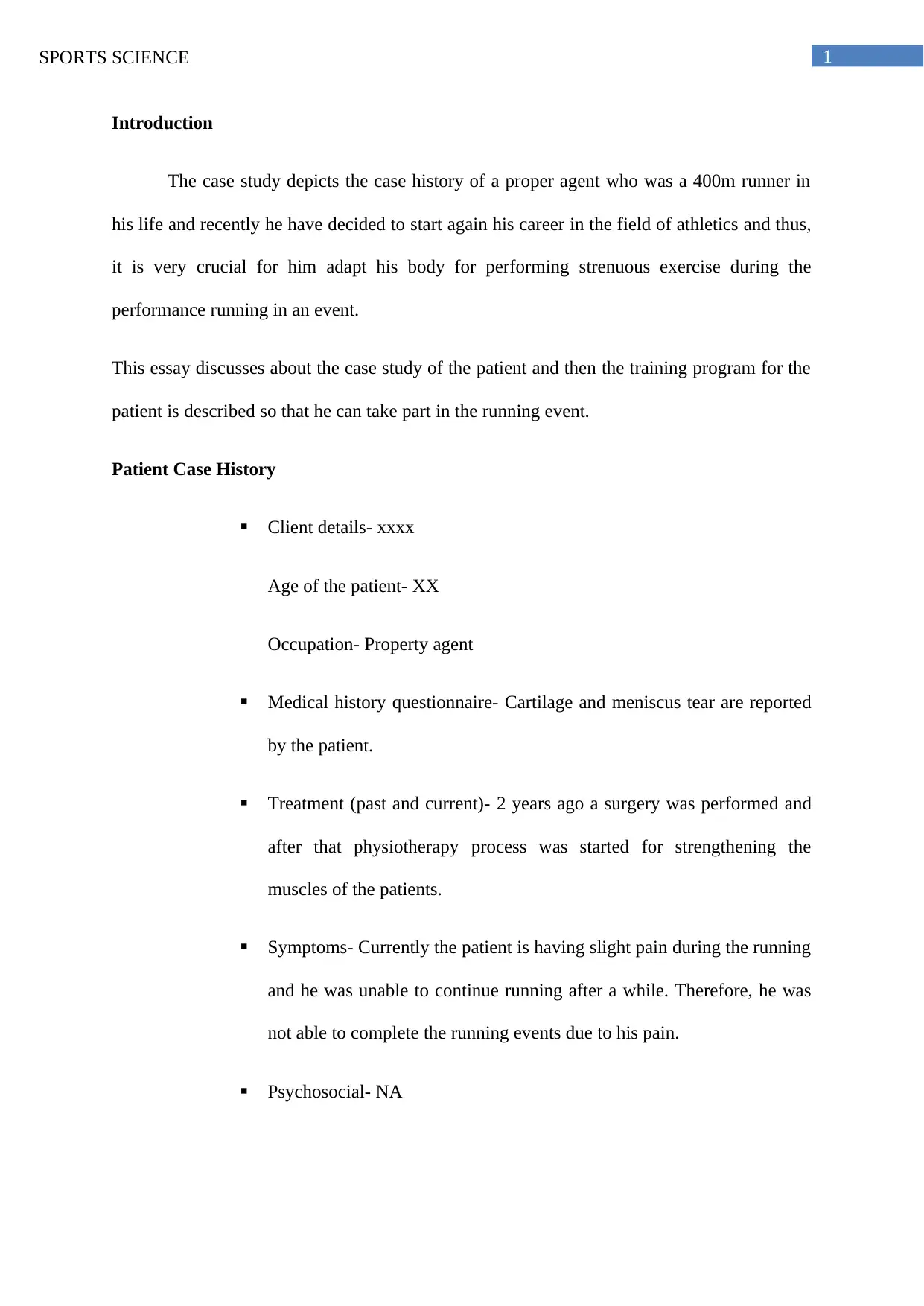
1SPORTS SCIENCE
Introduction
The case study depicts the case history of a proper agent who was a 400m runner in
his life and recently he have decided to start again his career in the field of athletics and thus,
it is very crucial for him adapt his body for performing strenuous exercise during the
performance running in an event.
This essay discusses about the case study of the patient and then the training program for the
patient is described so that he can take part in the running event.
Patient Case History
Client details- xxxx
Age of the patient- XX
Occupation- Property agent
Medical history questionnaire- Cartilage and meniscus tear are reported
by the patient.
Treatment (past and current)- 2 years ago a surgery was performed and
after that physiotherapy process was started for strengthening the
muscles of the patients.
Symptoms- Currently the patient is having slight pain during the running
and he was unable to continue running after a while. Therefore, he was
not able to complete the running events due to his pain.
Psychosocial- NA
Introduction
The case study depicts the case history of a proper agent who was a 400m runner in
his life and recently he have decided to start again his career in the field of athletics and thus,
it is very crucial for him adapt his body for performing strenuous exercise during the
performance running in an event.
This essay discusses about the case study of the patient and then the training program for the
patient is described so that he can take part in the running event.
Patient Case History
Client details- xxxx
Age of the patient- XX
Occupation- Property agent
Medical history questionnaire- Cartilage and meniscus tear are reported
by the patient.
Treatment (past and current)- 2 years ago a surgery was performed and
after that physiotherapy process was started for strengthening the
muscles of the patients.
Symptoms- Currently the patient is having slight pain during the running
and he was unable to continue running after a while. Therefore, he was
not able to complete the running events due to his pain.
Psychosocial- NA
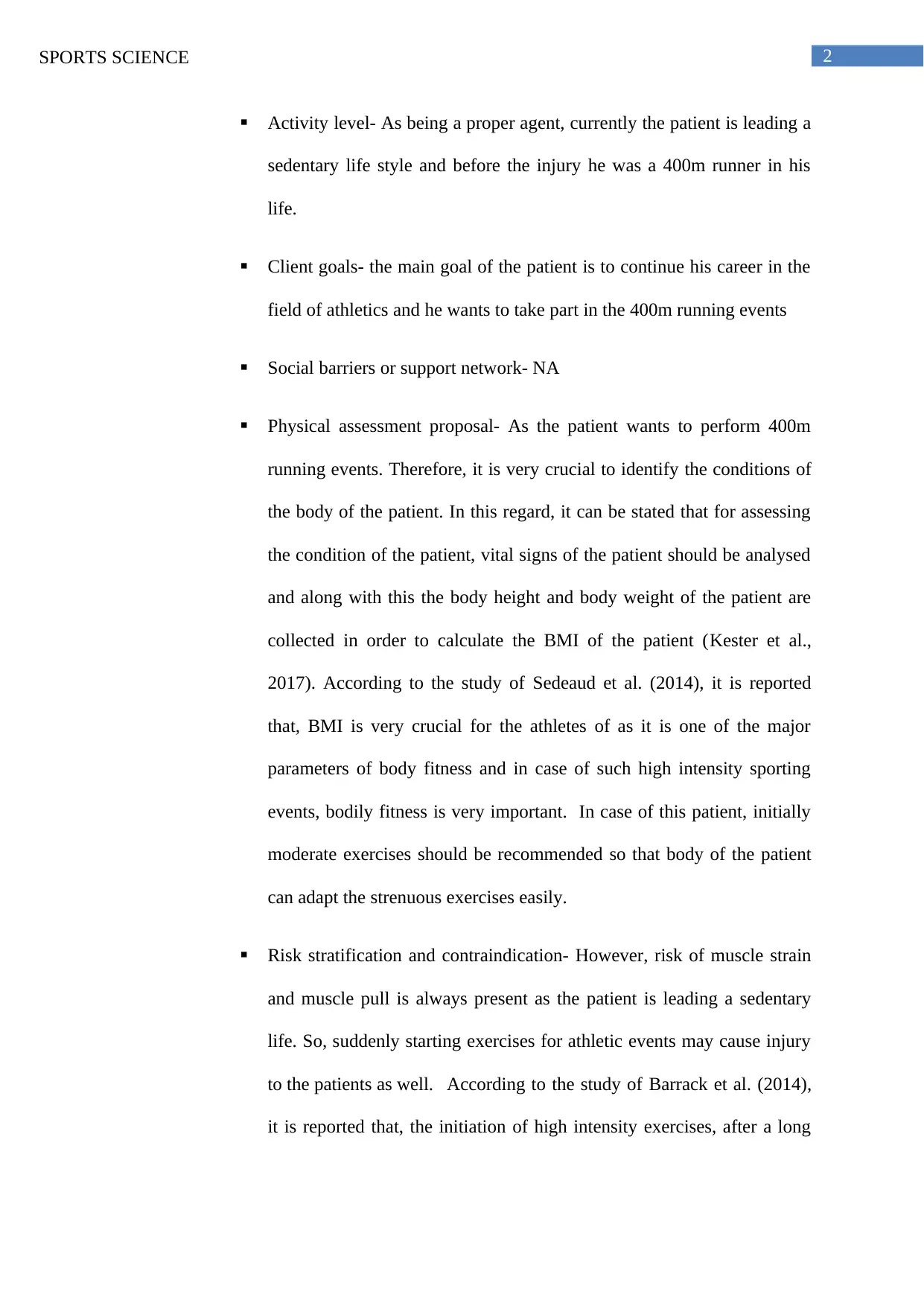
2SPORTS SCIENCE
Activity level- As being a proper agent, currently the patient is leading a
sedentary life style and before the injury he was a 400m runner in his
life.
Client goals- the main goal of the patient is to continue his career in the
field of athletics and he wants to take part in the 400m running events
Social barriers or support network- NA
Physical assessment proposal- As the patient wants to perform 400m
running events. Therefore, it is very crucial to identify the conditions of
the body of the patient. In this regard, it can be stated that for assessing
the condition of the patient, vital signs of the patient should be analysed
and along with this the body height and body weight of the patient are
collected in order to calculate the BMI of the patient (Kester et al.,
2017). According to the study of Sedeaud et al. (2014), it is reported
that, BMI is very crucial for the athletes of as it is one of the major
parameters of body fitness and in case of such high intensity sporting
events, bodily fitness is very important. In case of this patient, initially
moderate exercises should be recommended so that body of the patient
can adapt the strenuous exercises easily.
Risk stratification and contraindication- However, risk of muscle strain
and muscle pull is always present as the patient is leading a sedentary
life. So, suddenly starting exercises for athletic events may cause injury
to the patients as well. According to the study of Barrack et al. (2014),
it is reported that, the initiation of high intensity exercises, after a long
Activity level- As being a proper agent, currently the patient is leading a
sedentary life style and before the injury he was a 400m runner in his
life.
Client goals- the main goal of the patient is to continue his career in the
field of athletics and he wants to take part in the 400m running events
Social barriers or support network- NA
Physical assessment proposal- As the patient wants to perform 400m
running events. Therefore, it is very crucial to identify the conditions of
the body of the patient. In this regard, it can be stated that for assessing
the condition of the patient, vital signs of the patient should be analysed
and along with this the body height and body weight of the patient are
collected in order to calculate the BMI of the patient (Kester et al.,
2017). According to the study of Sedeaud et al. (2014), it is reported
that, BMI is very crucial for the athletes of as it is one of the major
parameters of body fitness and in case of such high intensity sporting
events, bodily fitness is very important. In case of this patient, initially
moderate exercises should be recommended so that body of the patient
can adapt the strenuous exercises easily.
Risk stratification and contraindication- However, risk of muscle strain
and muscle pull is always present as the patient is leading a sedentary
life. So, suddenly starting exercises for athletic events may cause injury
to the patients as well. According to the study of Barrack et al. (2014),
it is reported that, the initiation of high intensity exercises, after a long
⊘ This is a preview!⊘
Do you want full access?
Subscribe today to unlock all pages.

Trusted by 1+ million students worldwide
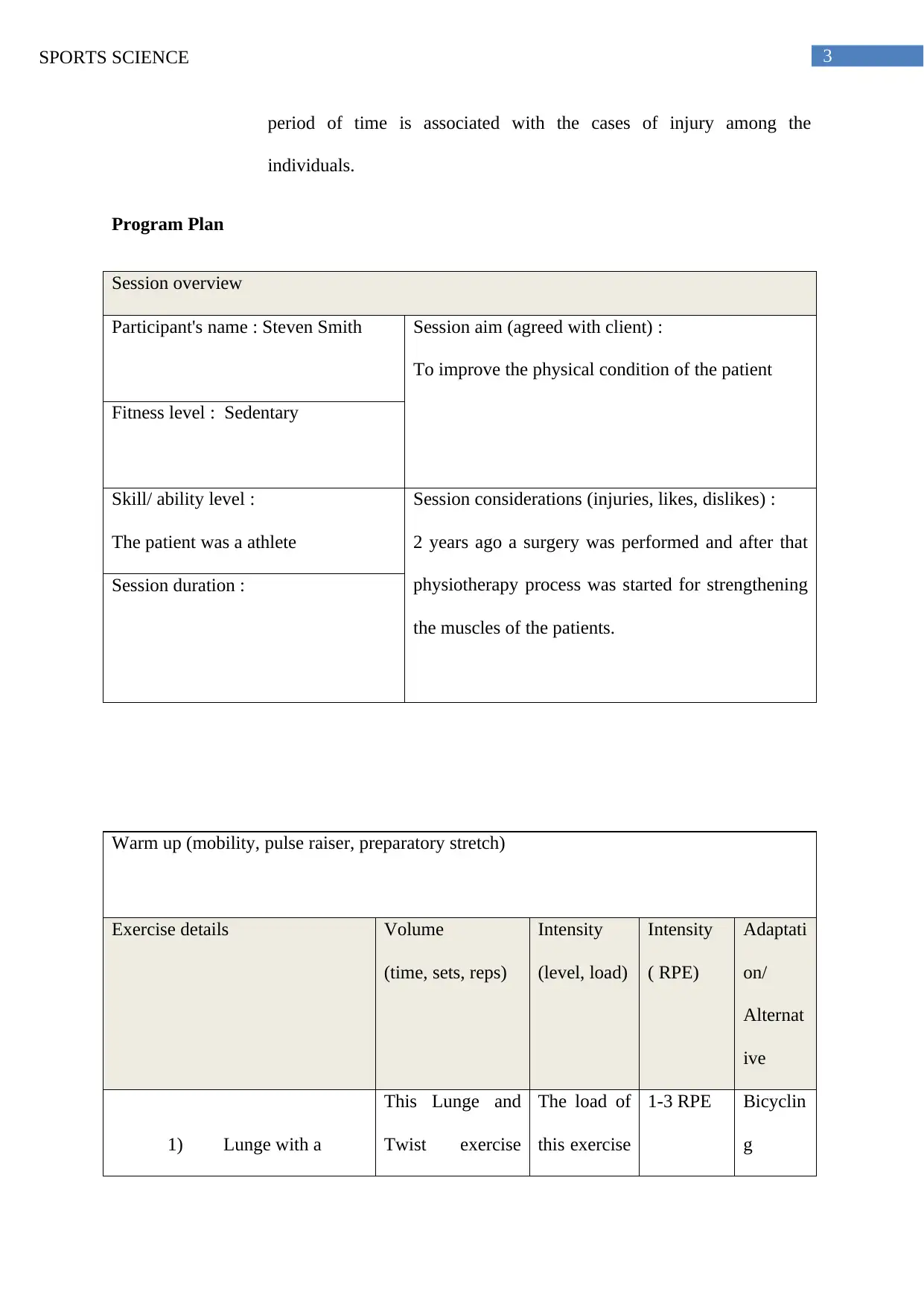
3SPORTS SCIENCE
period of time is associated with the cases of injury among the
individuals.
Program Plan
Session overview
Participant's name : Steven Smith Session aim (agreed with client) :
To improve the physical condition of the patient
Fitness level : Sedentary
Skill/ ability level :
The patient was a athlete
Session considerations (injuries, likes, dislikes) :
2 years ago a surgery was performed and after that
physiotherapy process was started for strengthening
the muscles of the patients.
Session duration :
Warm up (mobility, pulse raiser, preparatory stretch)
Exercise details Volume
(time, sets, reps)
Intensity
(level, load)
Intensity
( RPE)
Adaptati
on/
Alternat
ive
1) Lunge with a
This Lunge and
Twist exercise
The load of
this exercise
1-3 RPE Bicyclin
g
period of time is associated with the cases of injury among the
individuals.
Program Plan
Session overview
Participant's name : Steven Smith Session aim (agreed with client) :
To improve the physical condition of the patient
Fitness level : Sedentary
Skill/ ability level :
The patient was a athlete
Session considerations (injuries, likes, dislikes) :
2 years ago a surgery was performed and after that
physiotherapy process was started for strengthening
the muscles of the patients.
Session duration :
Warm up (mobility, pulse raiser, preparatory stretch)
Exercise details Volume
(time, sets, reps)
Intensity
(level, load)
Intensity
( RPE)
Adaptati
on/
Alternat
ive
1) Lunge with a
This Lunge and
Twist exercise
The load of
this exercise
1-3 RPE Bicyclin
g
Paraphrase This Document
Need a fresh take? Get an instant paraphrase of this document with our AI Paraphraser
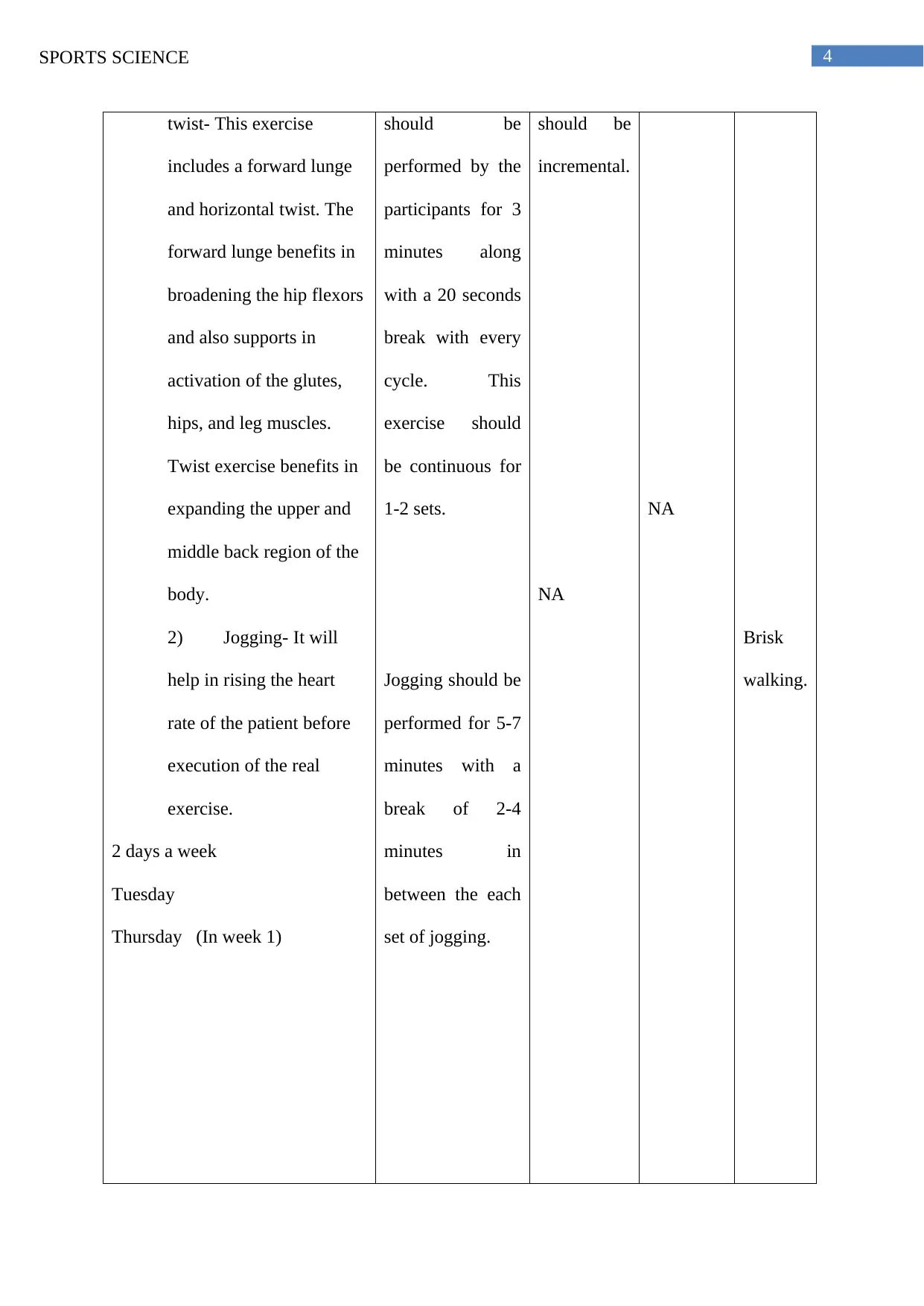
4SPORTS SCIENCE
twist- This exercise
includes a forward lunge
and horizontal twist. The
forward lunge benefits in
broadening the hip flexors
and also supports in
activation of the glutes,
hips, and leg muscles.
Twist exercise benefits in
expanding the upper and
middle back region of the
body.
2) Jogging- It will
help in rising the heart
rate of the patient before
execution of the real
exercise.
2 days a week
Tuesday
Thursday (In week 1)
should be
performed by the
participants for 3
minutes along
with a 20 seconds
break with every
cycle. This
exercise should
be continuous for
1-2 sets.
Jogging should be
performed for 5-7
minutes with a
break of 2-4
minutes in
between the each
set of jogging.
should be
incremental.
NA
NA
Brisk
walking.
twist- This exercise
includes a forward lunge
and horizontal twist. The
forward lunge benefits in
broadening the hip flexors
and also supports in
activation of the glutes,
hips, and leg muscles.
Twist exercise benefits in
expanding the upper and
middle back region of the
body.
2) Jogging- It will
help in rising the heart
rate of the patient before
execution of the real
exercise.
2 days a week
Tuesday
Thursday (In week 1)
should be
performed by the
participants for 3
minutes along
with a 20 seconds
break with every
cycle. This
exercise should
be continuous for
1-2 sets.
Jogging should be
performed for 5-7
minutes with a
break of 2-4
minutes in
between the each
set of jogging.
should be
incremental.
NA
NA
Brisk
walking.
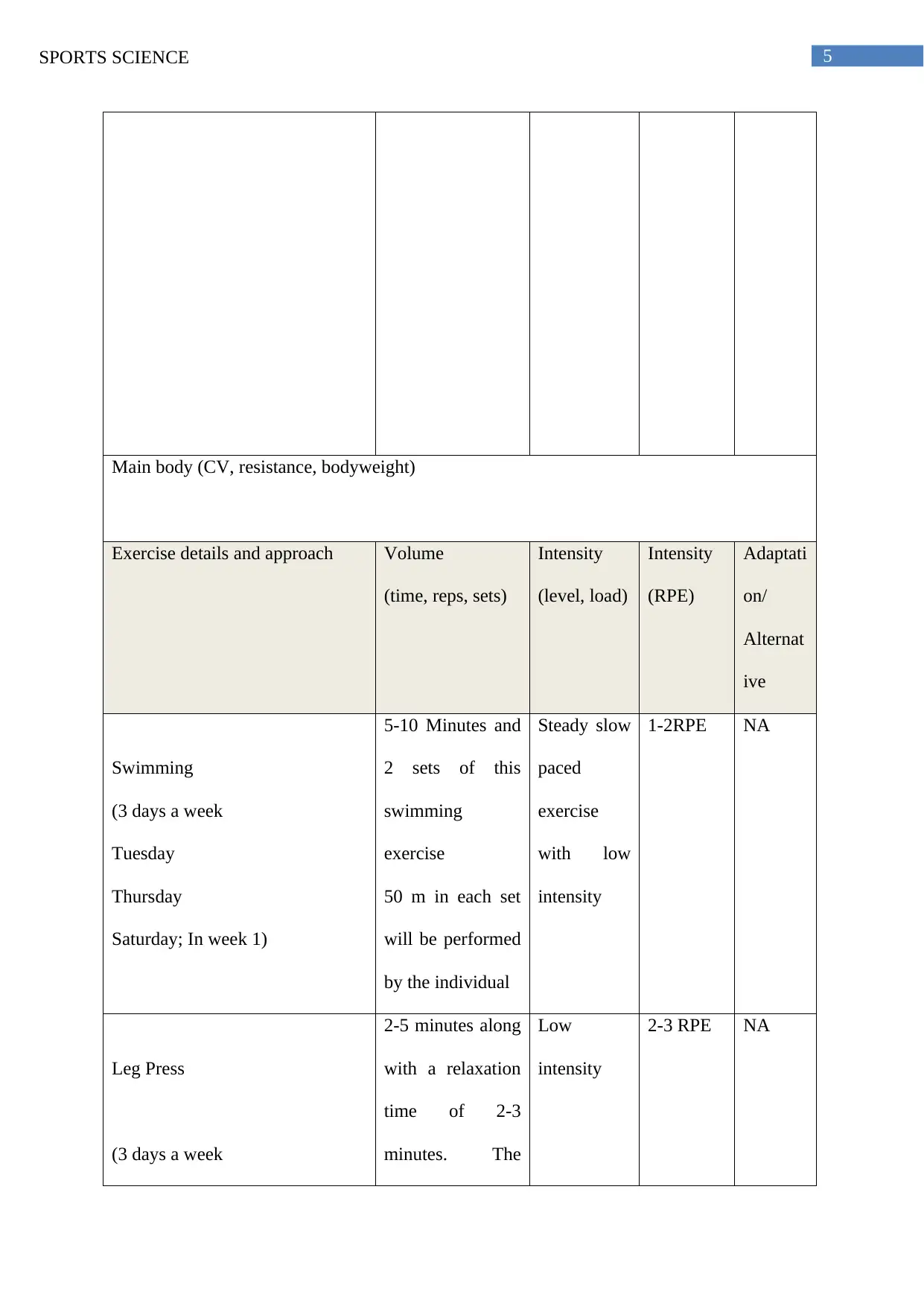
5SPORTS SCIENCE
Main body (CV, resistance, bodyweight)
Exercise details and approach Volume
(time, reps, sets)
Intensity
(level, load)
Intensity
(RPE)
Adaptati
on/
Alternat
ive
Swimming
(3 days a week
Tuesday
Thursday
Saturday; In week 1)
5-10 Minutes and
2 sets of this
swimming
exercise
50 m in each set
will be performed
by the individual
Steady slow
paced
exercise
with low
intensity
1-2RPE NA
Leg Press
(3 days a week
2-5 minutes along
with a relaxation
time of 2-3
minutes. The
Low
intensity
2-3 RPE NA
Main body (CV, resistance, bodyweight)
Exercise details and approach Volume
(time, reps, sets)
Intensity
(level, load)
Intensity
(RPE)
Adaptati
on/
Alternat
ive
Swimming
(3 days a week
Tuesday
Thursday
Saturday; In week 1)
5-10 Minutes and
2 sets of this
swimming
exercise
50 m in each set
will be performed
by the individual
Steady slow
paced
exercise
with low
intensity
1-2RPE NA
Leg Press
(3 days a week
2-5 minutes along
with a relaxation
time of 2-3
minutes. The
Low
intensity
2-3 RPE NA
⊘ This is a preview!⊘
Do you want full access?
Subscribe today to unlock all pages.

Trusted by 1+ million students worldwide
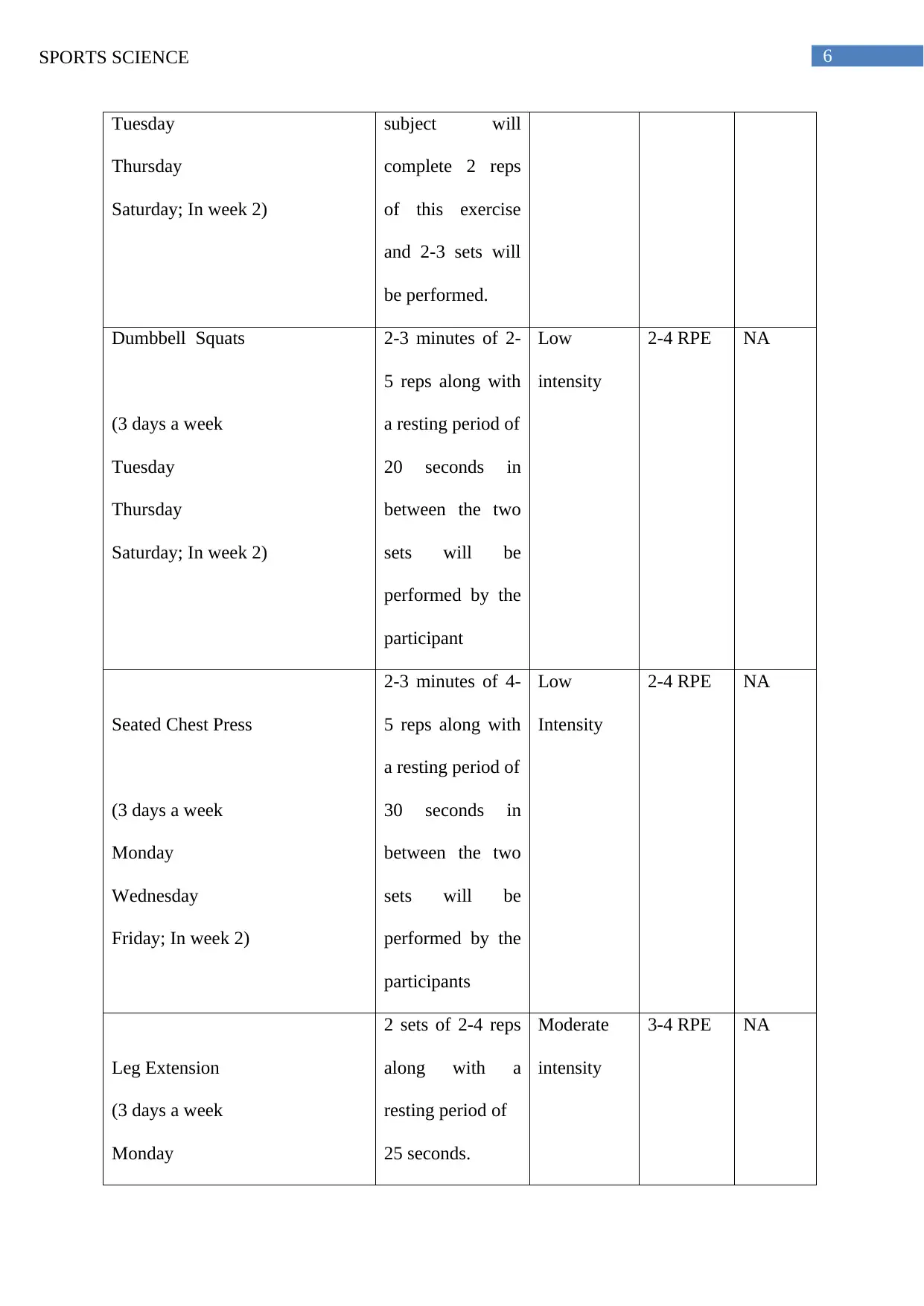
6SPORTS SCIENCE
Tuesday
Thursday
Saturday; In week 2)
subject will
complete 2 reps
of this exercise
and 2-3 sets will
be performed.
Dumbbell Squats
(3 days a week
Tuesday
Thursday
Saturday; In week 2)
2-3 minutes of 2-
5 reps along with
a resting period of
20 seconds in
between the two
sets will be
performed by the
participant
Low
intensity
2-4 RPE NA
Seated Chest Press
(3 days a week
Monday
Wednesday
Friday; In week 2)
2-3 minutes of 4-
5 reps along with
a resting period of
30 seconds in
between the two
sets will be
performed by the
participants
Low
Intensity
2-4 RPE NA
Leg Extension
(3 days a week
Monday
2 sets of 2-4 reps
along with a
resting period of
25 seconds.
Moderate
intensity
3-4 RPE NA
Tuesday
Thursday
Saturday; In week 2)
subject will
complete 2 reps
of this exercise
and 2-3 sets will
be performed.
Dumbbell Squats
(3 days a week
Tuesday
Thursday
Saturday; In week 2)
2-3 minutes of 2-
5 reps along with
a resting period of
20 seconds in
between the two
sets will be
performed by the
participant
Low
intensity
2-4 RPE NA
Seated Chest Press
(3 days a week
Monday
Wednesday
Friday; In week 2)
2-3 minutes of 4-
5 reps along with
a resting period of
30 seconds in
between the two
sets will be
performed by the
participants
Low
Intensity
2-4 RPE NA
Leg Extension
(3 days a week
Monday
2 sets of 2-4 reps
along with a
resting period of
25 seconds.
Moderate
intensity
3-4 RPE NA
Paraphrase This Document
Need a fresh take? Get an instant paraphrase of this document with our AI Paraphraser
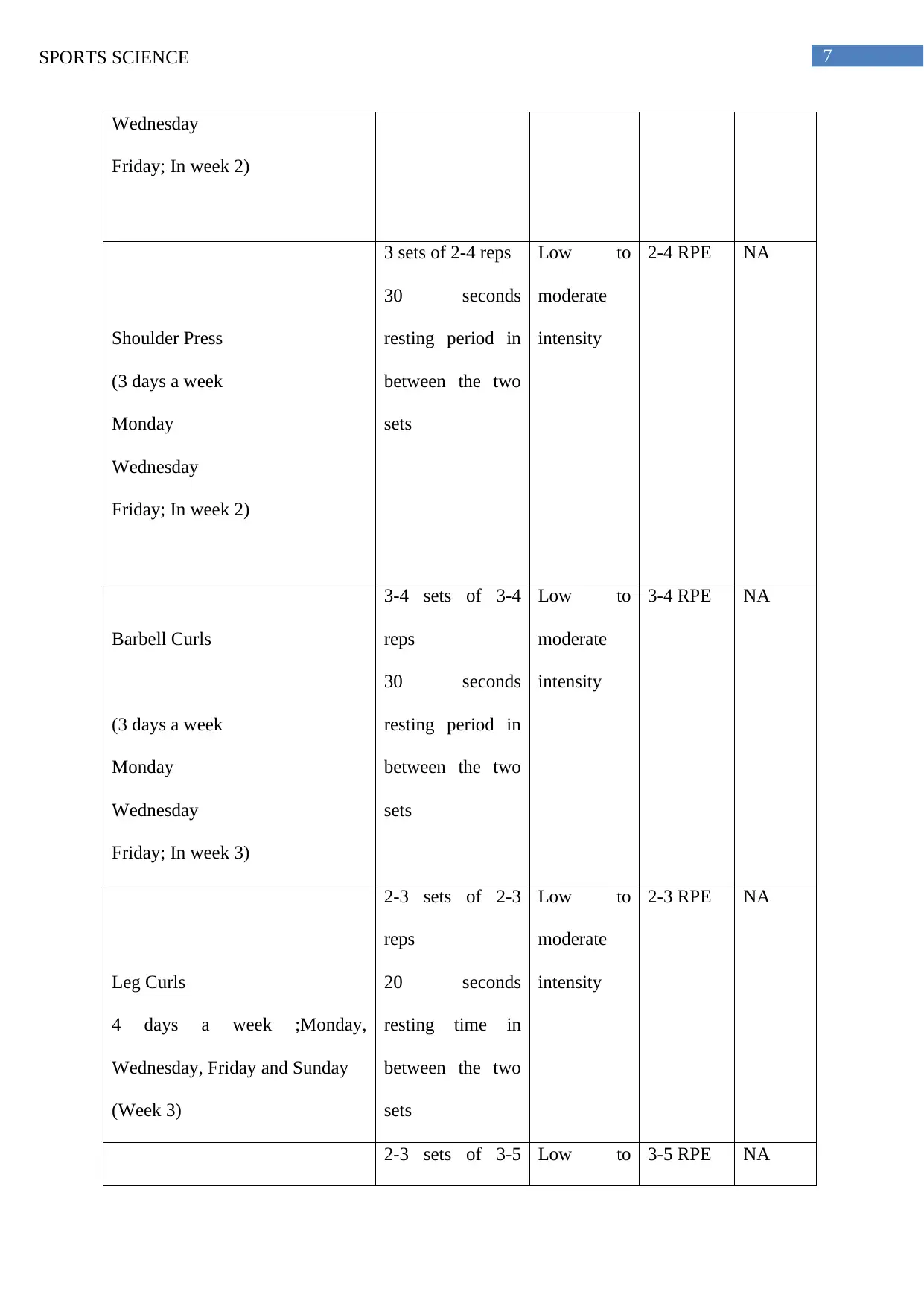
7SPORTS SCIENCE
Wednesday
Friday; In week 2)
Shoulder Press
(3 days a week
Monday
Wednesday
Friday; In week 2)
3 sets of 2-4 reps
30 seconds
resting period in
between the two
sets
Low to
moderate
intensity
2-4 RPE NA
Barbell Curls
(3 days a week
Monday
Wednesday
Friday; In week 3)
3-4 sets of 3-4
reps
30 seconds
resting period in
between the two
sets
Low to
moderate
intensity
3-4 RPE NA
Leg Curls
4 days a week ;Monday,
Wednesday, Friday and Sunday
(Week 3)
2-3 sets of 2-3
reps
20 seconds
resting time in
between the two
sets
Low to
moderate
intensity
2-3 RPE NA
2-3 sets of 3-5 Low to 3-5 RPE NA
Wednesday
Friday; In week 2)
Shoulder Press
(3 days a week
Monday
Wednesday
Friday; In week 2)
3 sets of 2-4 reps
30 seconds
resting period in
between the two
sets
Low to
moderate
intensity
2-4 RPE NA
Barbell Curls
(3 days a week
Monday
Wednesday
Friday; In week 3)
3-4 sets of 3-4
reps
30 seconds
resting period in
between the two
sets
Low to
moderate
intensity
3-4 RPE NA
Leg Curls
4 days a week ;Monday,
Wednesday, Friday and Sunday
(Week 3)
2-3 sets of 2-3
reps
20 seconds
resting time in
between the two
sets
Low to
moderate
intensity
2-3 RPE NA
2-3 sets of 3-5 Low to 3-5 RPE NA
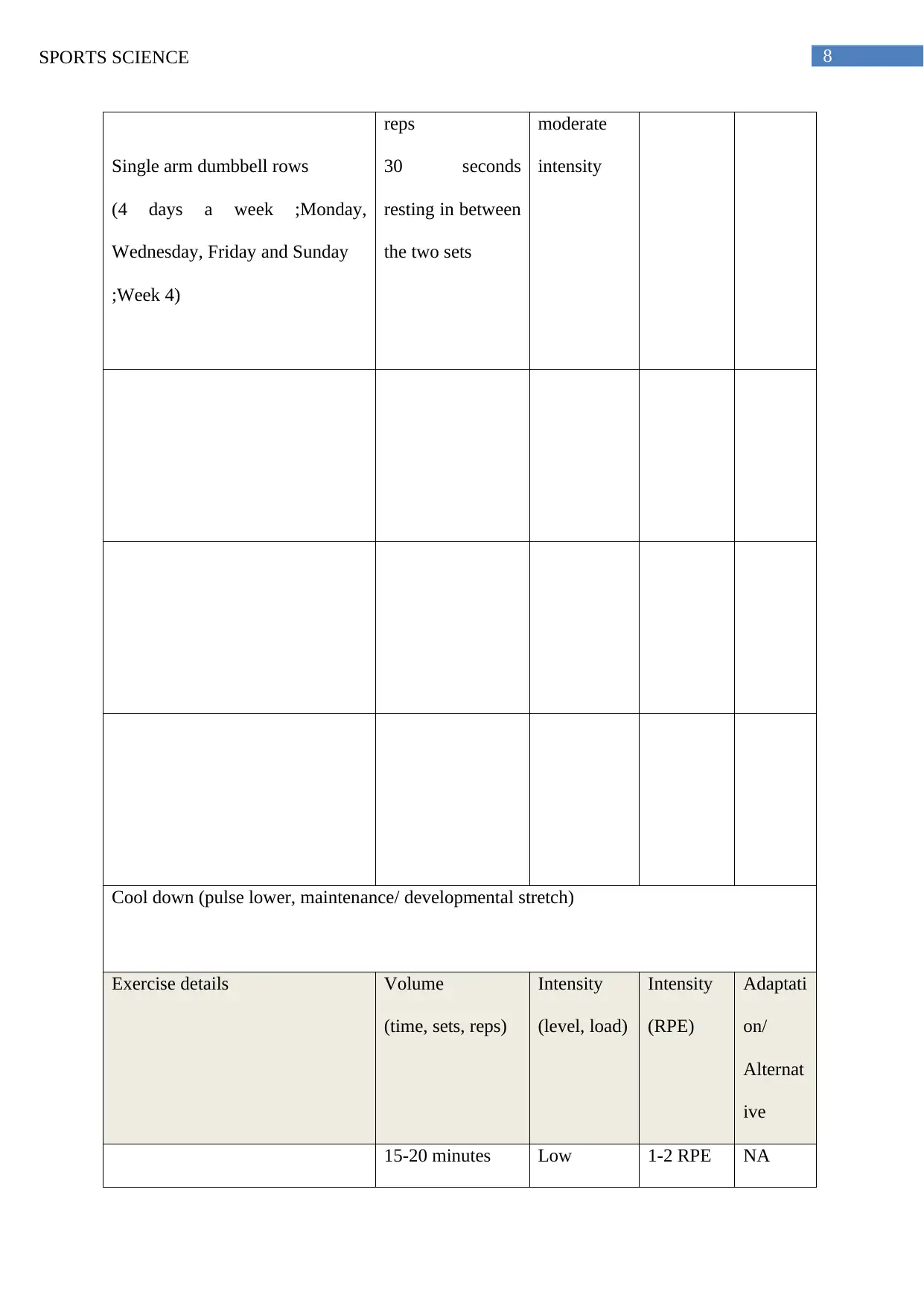
8SPORTS SCIENCE
Single arm dumbbell rows
(4 days a week ;Monday,
Wednesday, Friday and Sunday
;Week 4)
reps
30 seconds
resting in between
the two sets
moderate
intensity
Cool down (pulse lower, maintenance/ developmental stretch)
Exercise details Volume
(time, sets, reps)
Intensity
(level, load)
Intensity
(RPE)
Adaptati
on/
Alternat
ive
15-20 minutes Low 1-2 RPE NA
Single arm dumbbell rows
(4 days a week ;Monday,
Wednesday, Friday and Sunday
;Week 4)
reps
30 seconds
resting in between
the two sets
moderate
intensity
Cool down (pulse lower, maintenance/ developmental stretch)
Exercise details Volume
(time, sets, reps)
Intensity
(level, load)
Intensity
(RPE)
Adaptati
on/
Alternat
ive
15-20 minutes Low 1-2 RPE NA
⊘ This is a preview!⊘
Do you want full access?
Subscribe today to unlock all pages.

Trusted by 1+ million students worldwide
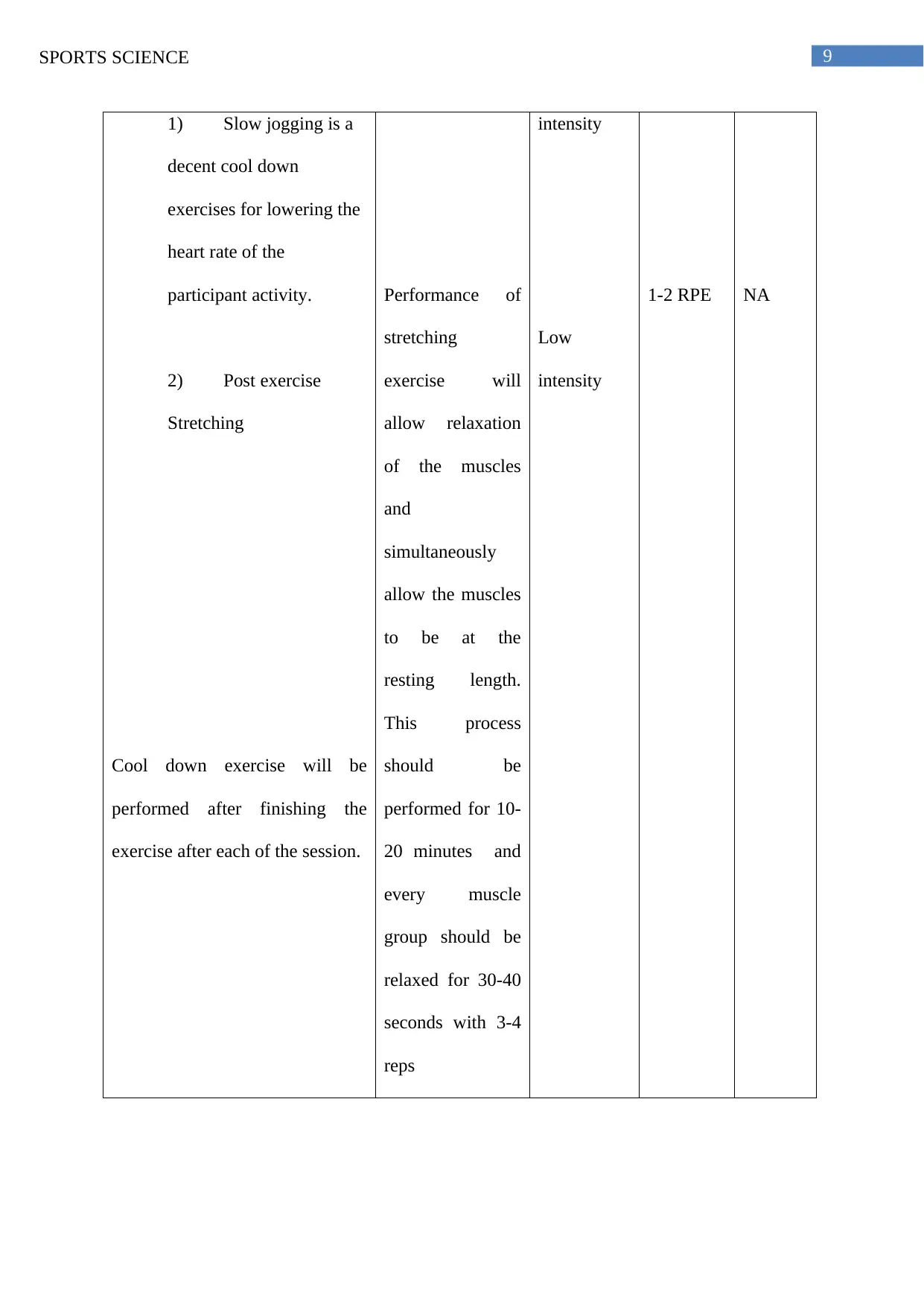
9SPORTS SCIENCE
1) Slow jogging is a
decent cool down
exercises for lowering the
heart rate of the
participant activity.
2) Post exercise
Stretching
Cool down exercise will be
performed after finishing the
exercise after each of the session.
Performance of
stretching
exercise will
allow relaxation
of the muscles
and
simultaneously
allow the muscles
to be at the
resting length.
This process
should be
performed for 10-
20 minutes and
every muscle
group should be
relaxed for 30-40
seconds with 3-4
reps
intensity
Low
intensity
1-2 RPE NA
1) Slow jogging is a
decent cool down
exercises for lowering the
heart rate of the
participant activity.
2) Post exercise
Stretching
Cool down exercise will be
performed after finishing the
exercise after each of the session.
Performance of
stretching
exercise will
allow relaxation
of the muscles
and
simultaneously
allow the muscles
to be at the
resting length.
This process
should be
performed for 10-
20 minutes and
every muscle
group should be
relaxed for 30-40
seconds with 3-4
reps
intensity
Low
intensity
1-2 RPE NA
Paraphrase This Document
Need a fresh take? Get an instant paraphrase of this document with our AI Paraphraser
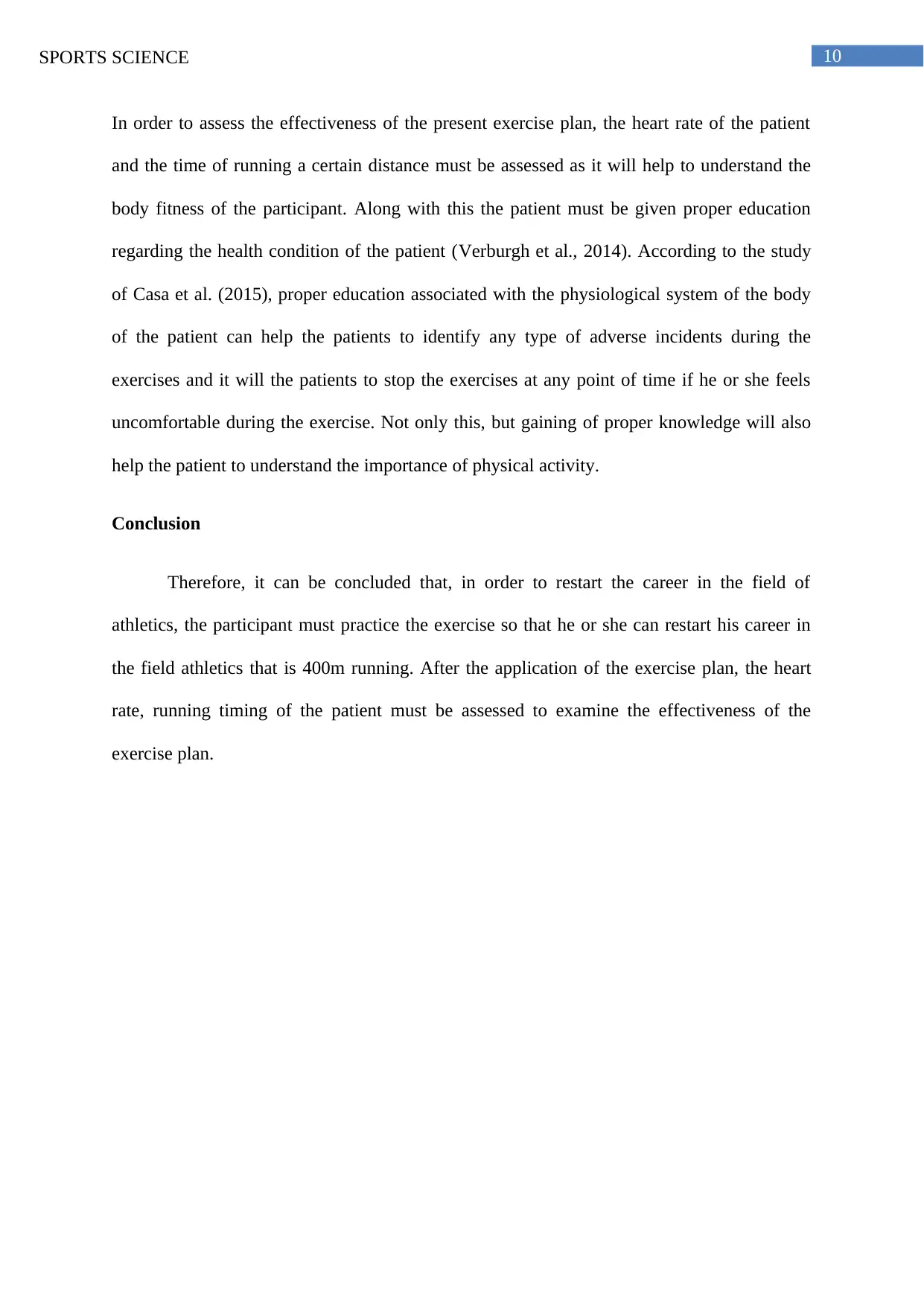
10SPORTS SCIENCE
In order to assess the effectiveness of the present exercise plan, the heart rate of the patient
and the time of running a certain distance must be assessed as it will help to understand the
body fitness of the participant. Along with this the patient must be given proper education
regarding the health condition of the patient (Verburgh et al., 2014). According to the study
of Casa et al. (2015), proper education associated with the physiological system of the body
of the patient can help the patients to identify any type of adverse incidents during the
exercises and it will the patients to stop the exercises at any point of time if he or she feels
uncomfortable during the exercise. Not only this, but gaining of proper knowledge will also
help the patient to understand the importance of physical activity.
Conclusion
Therefore, it can be concluded that, in order to restart the career in the field of
athletics, the participant must practice the exercise so that he or she can restart his career in
the field athletics that is 400m running. After the application of the exercise plan, the heart
rate, running timing of the patient must be assessed to examine the effectiveness of the
exercise plan.
In order to assess the effectiveness of the present exercise plan, the heart rate of the patient
and the time of running a certain distance must be assessed as it will help to understand the
body fitness of the participant. Along with this the patient must be given proper education
regarding the health condition of the patient (Verburgh et al., 2014). According to the study
of Casa et al. (2015), proper education associated with the physiological system of the body
of the patient can help the patients to identify any type of adverse incidents during the
exercises and it will the patients to stop the exercises at any point of time if he or she feels
uncomfortable during the exercise. Not only this, but gaining of proper knowledge will also
help the patient to understand the importance of physical activity.
Conclusion
Therefore, it can be concluded that, in order to restart the career in the field of
athletics, the participant must practice the exercise so that he or she can restart his career in
the field athletics that is 400m running. After the application of the exercise plan, the heart
rate, running timing of the patient must be assessed to examine the effectiveness of the
exercise plan.
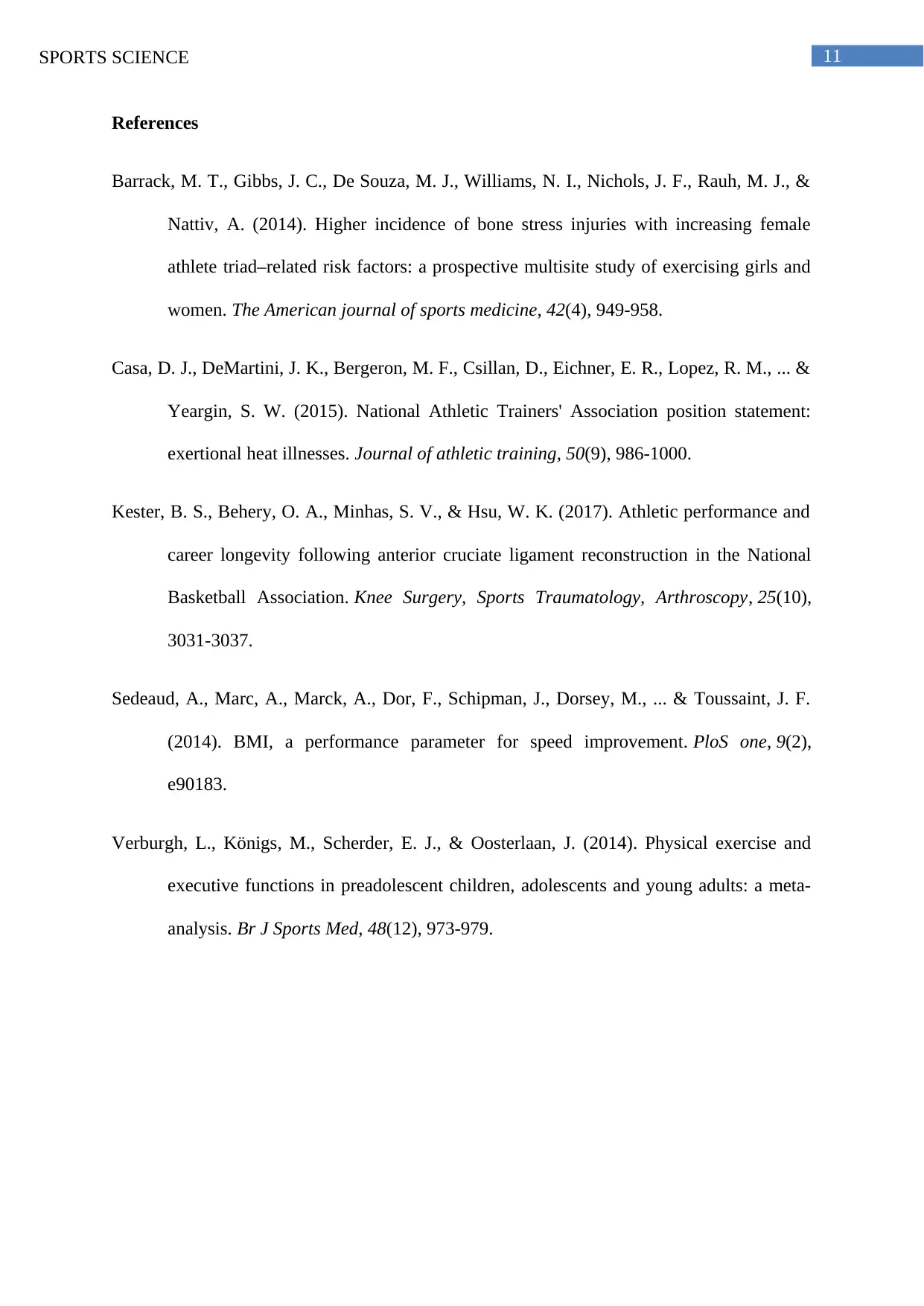
11SPORTS SCIENCE
References
Barrack, M. T., Gibbs, J. C., De Souza, M. J., Williams, N. I., Nichols, J. F., Rauh, M. J., &
Nattiv, A. (2014). Higher incidence of bone stress injuries with increasing female
athlete triad–related risk factors: a prospective multisite study of exercising girls and
women. The American journal of sports medicine, 42(4), 949-958.
Casa, D. J., DeMartini, J. K., Bergeron, M. F., Csillan, D., Eichner, E. R., Lopez, R. M., ... &
Yeargin, S. W. (2015). National Athletic Trainers' Association position statement:
exertional heat illnesses. Journal of athletic training, 50(9), 986-1000.
Kester, B. S., Behery, O. A., Minhas, S. V., & Hsu, W. K. (2017). Athletic performance and
career longevity following anterior cruciate ligament reconstruction in the National
Basketball Association. Knee Surgery, Sports Traumatology, Arthroscopy, 25(10),
3031-3037.
Sedeaud, A., Marc, A., Marck, A., Dor, F., Schipman, J., Dorsey, M., ... & Toussaint, J. F.
(2014). BMI, a performance parameter for speed improvement. PloS one, 9(2),
e90183.
Verburgh, L., Königs, M., Scherder, E. J., & Oosterlaan, J. (2014). Physical exercise and
executive functions in preadolescent children, adolescents and young adults: a meta-
analysis. Br J Sports Med, 48(12), 973-979.
References
Barrack, M. T., Gibbs, J. C., De Souza, M. J., Williams, N. I., Nichols, J. F., Rauh, M. J., &
Nattiv, A. (2014). Higher incidence of bone stress injuries with increasing female
athlete triad–related risk factors: a prospective multisite study of exercising girls and
women. The American journal of sports medicine, 42(4), 949-958.
Casa, D. J., DeMartini, J. K., Bergeron, M. F., Csillan, D., Eichner, E. R., Lopez, R. M., ... &
Yeargin, S. W. (2015). National Athletic Trainers' Association position statement:
exertional heat illnesses. Journal of athletic training, 50(9), 986-1000.
Kester, B. S., Behery, O. A., Minhas, S. V., & Hsu, W. K. (2017). Athletic performance and
career longevity following anterior cruciate ligament reconstruction in the National
Basketball Association. Knee Surgery, Sports Traumatology, Arthroscopy, 25(10),
3031-3037.
Sedeaud, A., Marc, A., Marck, A., Dor, F., Schipman, J., Dorsey, M., ... & Toussaint, J. F.
(2014). BMI, a performance parameter for speed improvement. PloS one, 9(2),
e90183.
Verburgh, L., Königs, M., Scherder, E. J., & Oosterlaan, J. (2014). Physical exercise and
executive functions in preadolescent children, adolescents and young adults: a meta-
analysis. Br J Sports Med, 48(12), 973-979.
⊘ This is a preview!⊘
Do you want full access?
Subscribe today to unlock all pages.

Trusted by 1+ million students worldwide
1 out of 14
Related Documents
Your All-in-One AI-Powered Toolkit for Academic Success.
+13062052269
info@desklib.com
Available 24*7 on WhatsApp / Email
![[object Object]](/_next/static/media/star-bottom.7253800d.svg)
Unlock your academic potential
Copyright © 2020–2025 A2Z Services. All Rights Reserved. Developed and managed by ZUCOL.




